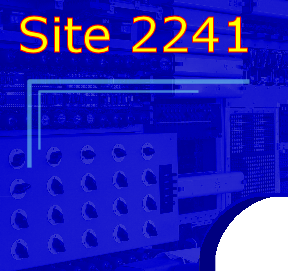January 2009 Archives
Understanding Multicasting
On 17 February 2009, analog television signals will no longer be broadcast in the United States. You may have already bought either a digital-ready television, or you may have bought a converter box. Perhaps with a coupon from the Federal government. Either way, if you're already receiving digital television, either over-the-air or through a cable provider, you may have noticed some different channel numbers. That's what I'm going to explain here.
In the original spectrum plan for broadcast television, the FCC allocated 82 channels (2 - 83). A channel was a 6 MHz-wide slice of spectrum. For example, channel 2 occupied the frequencies 54 - 60 MHz. Channel 20 occupied 506 - 512 MHz. Each of these channels could carry one program at a time. Channel numbers referred to the RF channel that the FCC allocated to that broadcaster. Thus, when your television was tuned to channel 6, for example, that meant it was receiving a television signal being broadcast between 82 - 88 MHz.
It's not that simple with digital television. Digital television isn't a broadcast of video so much as it is a broadcast of digital bits. For over-the-air broadcasts, it's a stream of approximately 19.4 million bits each second (Mbits/sec), all packed into that same 6 MHz of bandwidth. (NOTE: The actual rate of the signal is higher, on the order of 32.3 Mbits/sec. But those extra bits are to ensure that the signal gets through with no errors and to help your receiver recover the information properly. The number of bits used for the audio and video data is 19.4 Mbits/sec.) Well, that bit stream can be used to send more than one video program at a time. This is called multicasting.
Remember how I said earlier that the channel number referred to the RF spectrum it used? Well, that's not necessarily true with digital. Part of that 19.4 Mbits/sec bit stream tells your television what channel number to display. And the channel number is now broken into two parts, such as "13.1" or "20.4". The first part (before the decimal point) is called the major channel number. It typically is the same as the old, analog channel number. Thus, if you have a analog channel 13 in your area, you may have already found a digital channel 13 as well. The difference is that the digital signal is on a frequency different than the analog one. Confused? Don't fret. After February 17th, the digital signal may be switched to the analog frequency (once the analog signal is turned off).
The second part of the number (after the decimal point) is called the minor channel number. How many minor channels can there be? Well, a low-grade video signal needs about 3 Mbits/sec. That means that a broadcaster has enough bits to send up to 6 video signals. High definition signals require more bits. Depending on the resolution, a hi-def signal can require almost the entire stream of 19.4 Mbits/sec. Typically, broadcasters put a mix of high-definition (1080 or 720) and standard definition (480i) on the broadcast. Each of the programs is assigned its own minor channel number. For example, in my area, channel 4 has three programs, denoted "4-1" through "4-3", on its one RF channel. Channel 26, a local PBS broadcaster, has 4 programs. These are denoted by channel numbers "26.1" through "26.4". I've taken a screen snapshot for each of these channels and displayed them on the left.
Oh, one minor point. You may notice that, on my TV, the channel number uses a hyphen between the major and minor channel numbers. Your TV may use a decimal point. What's the difference? Nothing. Nothing at all. It's up to the TV manufacturer whether they want to use a decimal point, a hyphen, or something else. They can use whatever they want.
These two channels, 4 and 26, are not transmitting on channels 4 (66 - 72 MHz) nor 26 (542 - 548 MHz). The digital channel 4 is actually being transmitted on RF channel 48 (674 - 680 MHz). Digital channel 26 is actually being transmitted on RF channel 27. Should you care about that? Not really. What does matter to you is that, when you're tuning through digital channels, you probably cannot switch as fast as you could through analog channels. That's because your TV works through the channels numerically. But while it's working through the virtual channels numerically, it's not working through the RF channels the same way. It may be having to tune the actual receiver all over the place. Again, that's because of the difference between the virtual channels and the RF channels.
Next, once your television has tuned to the correct frequency, it then has to demodulate the bit stream, sync to it, and pull the bits out for each specific program within the bit stream. That's a slower process than was required with the analog system.
But you needed to slow down your channel surfing anyway, didn't you?








